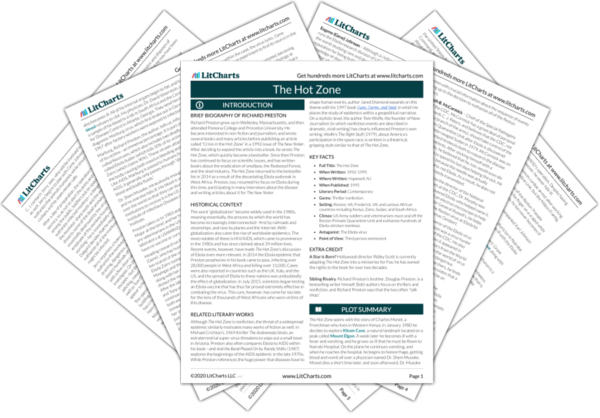Summary
Analysis
It is August 1993. Preston describes the road to Mount Elgon, which runs from the Kenyan highlands to the Rift valley. He adds that the road “is a segment of the AIDS highway, the Kinshasa Highway,” a trans-African road along which HIV traveled when it first began to break out. Preston traces the history of the highway, which was paved in the 1970s, soon before HIV began to show itself. He then reveals that he is familiar with the road to Mount Elgon because he traveled it when he was 12 along with his parents and brothers. When you experience Africa as a child, he says, “it becomes a section of your mind,” simultaneously familiar and foreign. He remembers the sights and smells of his childhood, and the masses of people whom he encountered during that time.
The narrative now becomes personal, as Preston becomes more of a character and tells readers about his journey to Kitum Cave, the theoretical source of Marburg virus. We once again encounter Kinshasa Highway, the road that helped spread HIV/AIDS, and we learn that Preston himself spent time in Africa. This personal detail helps to explain why he himself is so obsessed with Ebola. The detail about Kinshasa Highway, meanwhile, reminds us about ways in which human innovation can in fact spread deadly diseases.
Themes
Preston is currently driving along a bumpy road in a Land Rover along with an intrepid guide named Robin MacDonald, who once visited Mount Elgon as a child. The two pass cornfields, people, and herds of cattle, and Robin reminisces about a time when the land was wild and full of forests.
Although Robin’s memories of a time when the land was wild and free from humans may sound like a digression, it is in fact a reminder of how much humans have encroached on nature in recent decades. The spread of viruses such as HIV and Ebola is in large part due to this sudden expansion.
Themes
Preston explains that “Robin MacDonald is a professional hunter and safari guide.” He is also the son of a famous hunter named Iain MacDonald, who died in a plane crash when Robin was 13. He relates the many adventures of both Robin and his father, which include hunting an elephant in the middle of the desert for three days.
Robin’s experiences in the wild ensure that he understands the power of nature (unlike many more sheltered citizens in the US), but he is also arrogant and reckless, often putting his life in danger despite his knowledge of nature’s deadly potential.
Themes
There have apparently been “reports of tribal violence around Mount Elgon” because the Masai have been raiding an ethnic group called the Bukusu. Robin, however, has assured Preston that they will be relatively safe on their journey. Robin questions Preston about the reasons for his trip, and he replies that he just wants “to look around.” Ronin is relatively unworried about the possibility of an Ebola infection, although he’s quite impressed by its effects on male genitalia. The men discuss what Robin should do if Preston becomes ill. Preston cautions Robin not to touch him, but to deliver him to Nairobi Hospital immediately. The Land Rover passes the Cherangani Hills, and as they approach Mount Elgon it begins to rain. Preston asks Robin to find some bleach, and states that he hopes “it kills Marburg.”
The “tribal violence” that Preston mentions is yet another manifestation of the ways in which humans are detrimentally affecting their environment. Robin’s casual attitude about Ebola, is another example of how arrogant humans can be about deadly diseases, if they have not witnessed their effects firsthand. Preston, on the other hand, is all too conscious of what might happen to him if he’s exposed to Ebola. Despite this knowledge, however, his obsession with the mystery of Ebola/Marburg is so great that he’s willing to take the risk anyway.
Themes
Get the entire The Hot Zone LitChart as a printable PDF.

Preston describes the restaurants and small hotels that they pass along the way, many of which offer food, beer, lodging, and prostitutes. He explains that doctors believe that 90% of prostitutes who work along the main road have HIV/AIDS. In the area of Mount Elgon, 30% of men and women are infected with HIV. Most will die of AIDS, and many will pass the disease on to their children. The beginning of HIV/AIDS, he states, “was subtle,” because the disease takes years to kill its human hosts. Preston connects the paving of the Kinshasa Highway with the spread of the disease, explaining that when he was young, the road was nothing more than gravel and dust. Now, however, it is smooth and filled with pickup trucks and vans. He asserts that the paving of the Kinshasa Highway “turned out to be one of the most important events of the twentieth century,” and is responsible for the deaths of at least 10 million people.
The author digresses to talk about the spread of HIV/AIDS, and its massive prevalence around Mount Elgon. He returns once again to the construction of the Kinshasa Highway, emphasizing how it was only due to human innovation and globalization that HIV/AIDS was able to morph into a global pandemic. He then directly links the paving of the Kinshasa Highway with the massive amount of deaths caused by AIDS, hammering home the hidden danger that lies within the human need to constantly expand and innovate.
Themes












